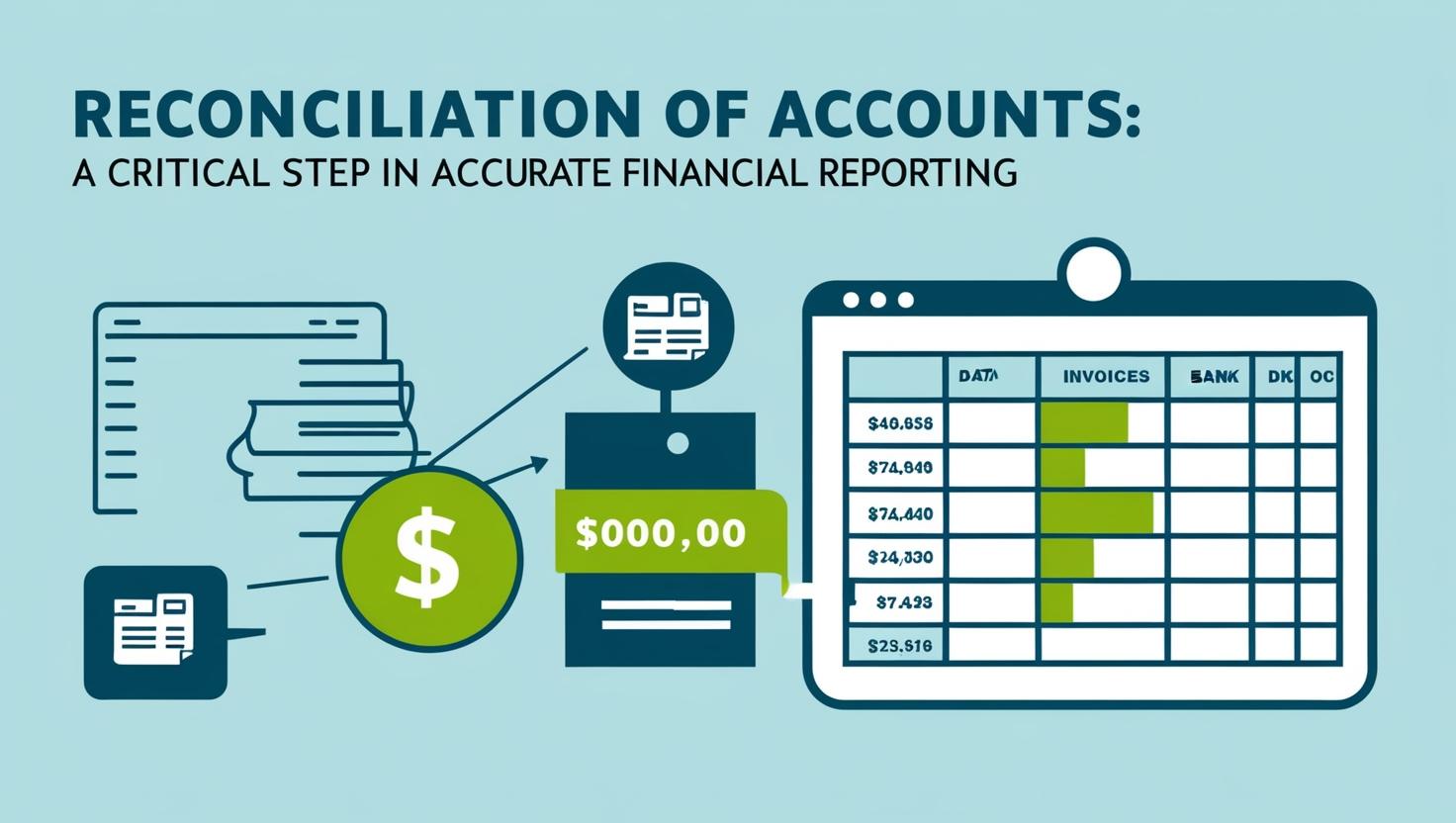What is Account Reconciliation?
Account reconciliation is the process of comparing and matching figures in your company’s financial records to those in external sources, such as bank statements, credit card statements, and financial statements from vendors or customers. This process helps ensure that the figures you report in your business’s financial statements align with the actual figures in your financial transactions, allowing for more accurate reporting and minimizing discrepancies.
Account reconciliation is essential for businesses of all sizes as it ensures that all financial records are correct, up-to-date, and in compliance with accounting standards and regulations. By regularly reconciling your accounts, you can identify any errors, omissions, or fraudulent transactions and correct them in a timely manner.
In this blog, we’ll discuss the role of account reconciliation in financial reporting, the types of accounts that need to be reconciled, the difference between manual and automated reconciliation, and the key outcomes of timely reconciliation.
Role in Financial Reporting
Account reconciliation plays a critical role in financial reporting. It ensures that a business’s financial records are accurate and reflect its actual financial status. The reconciliation process helps confirm that the balances on the general ledger, which serves as the central record of all financial transactions, match the balances in external sources such as bank accounts and credit card statements.
When financial reports are prepared at the end of an accounting period, the data must be both accurate and complete. Without reconciliation, discrepancies could result in incorrect financial statements, which could affect business decisions and lead to regulatory issues or audits.
Here are some of the key ways reconciliation of accounts impacts financial reporting:
- Accuracy of Financial Statements: Accurate reconciliations ensure that financial statements such as balance sheets and income statements provide a truthful view of the company’s performance and financial position.
- Tax Reporting Compliance: Timely reconciliations help businesses ensure that the financial data used for tax filings is correct, which helps avoid penalties from tax authorities.
- Audit Readiness: Reconciled accounts make the auditing process smoother. Businesses with well-reconciled accounts are less likely to face discrepancies or unexpected findings during an audit.
- Investor Confidence: For businesses seeking investors or funding, accurate reconciled accounts provide transparency, which can increase investor confidence.
Examples of Account Types Reconciled
Account reconciliation is essential for several types of accounts, and different businesses may require reconciliation for different types of financial records. Here are some common examples of account types that need to be reconciled:
1. Bank Account Reconciliation:
The most common type of reconciliation, this process involves comparing a company’s book records with those from the bank statement to ensure that all deposits, withdrawals, fees, and interest match. Any discrepancies, such as missed transactions, double payments, or fees not recorded, are identified and corrected.
2. Credit Card Reconciliation:
Similar to bank account reconciliation, this type involves comparing the business’s credit card records with the statements provided by the credit card company. This helps ensure that all charges, payments, and fees are accurately recorded.
3. Accounts Payable and Accounts Receivable Reconciliation:
This type of reconciliation focuses on matching the amounts owed to suppliers (accounts payable) or amounts due from customers (accounts receivable) with the recorded transactions in the company’s general ledger. Reconciliation ensures that unpaid invoices are recorded properly and that outstanding amounts are accurate.
4. General Ledger Reconciliation:
The general ledger is the central accounting record where all financial transactions are recorded. Reconciliation of the general ledger ensures that it matches the supporting documentation from other accounts, such as bank accounts, credit cards, and accounts payable/receivable. This process helps identify errors or inconsistencies in the recorded transactions.
5. Inventory Reconciliation:
For businesses that handle physical inventory, reconciling inventory accounts ensures that the number of items on hand matches what is recorded in the financial system. This can help identify issues such as inventory shrinkage, misreporting of stock levels, or inaccurate pricing.
6. Petty Cash Reconciliation:
Businesses that maintain petty cash for minor expenses need to reconcile the petty cash account regularly. This ensures that the amount of cash on hand matches the amount recorded in the ledger and that all expenditures are documented correctly.
Manual vs Automated Reconciliation
In the past, account reconciliation was performed manually, involving labor-intensive steps of comparing each transaction and record by hand. However, with the advent of technology, many businesses now use automated reconciliation tools to streamline the process and increase efficiency.
Manual Reconciliation
In manual reconciliation, accounting professionals compare each transaction in the company’s records with the relevant financial documents (e.g., bank statements, invoices). This process can be time-consuming and prone to human error, especially when handling large volumes of transactions.
Automated Reconciliation
Automated reconciliation uses accounting software and AI tools to perform the same process, but much more quickly and accurately. With automation, transactions are automatically matched, and discrepancies are flagged for further review. Automated tools can also generate reports on the status of reconciliations and even suggest corrective actions for discrepancies.
Benefits of Automated Reconciliation:
- Speed and Efficiency: Automated tools significantly reduce the time needed to perform reconciliations, allowing businesses to focus on more strategic activities.
- Accuracy: Automation reduces the risk of human error, ensuring more accurate financial records.
- Real-time Updates: Automated systems allow businesses to reconcile accounts more frequently, which means real-time, accurate financial data is always available.
The choice between manual and automated reconciliation largely depends on the size and complexity of your business. Smaller businesses with fewer transactions may find manual reconciliation sufficient, but larger businesses with higher transaction volumes may benefit from the speed and efficiency of automated tools.
Frequency of Reconciliation
The frequency of account reconciliation depends on the size and complexity of the business, as well as its operational needs. Here are some common reconciliation frequencies:
1. Daily Reconciliation:
For businesses that deal with large volumes of daily transactions, daily reconciliation can help ensure that errors are caught early. Retailers, e-commerce platforms, and financial institutions often reconcile daily to ensure accuracy in their records.
2. Monthly Reconciliation:
Many businesses reconcile their accounts monthly, at the end of each accounting period. This ensures that financial statements are accurate and ready for the month-end close, providing insights into the company’s financial health.
3. Quarterly Reconciliation:
Some businesses may perform reconciliations on a quarterly basis, especially if their transaction volumes are moderate. Quarterly reconciliation is also commonly done in preparation for quarterly financial reporting or tax filing.
4. Annual Reconciliation:
For businesses with fewer transactions or those that can operate without frequent updates to their records, annual reconciliation may suffice. This is often done in preparation for year-end financial statements or annual tax filings.
Key Outcomes of Timely Reconciliation
When account reconciliation is done timely and accurately, it leads to several positive outcomes:
1. Accurate Financial Reporting:
Timely reconciliation ensures that financial statements, such as balance sheets and income statements, reflect the true financial position of the business.
2. Improved Decision-Making:
With accurate and up-to-date financial data, business owners and managers can make better decisions regarding budgeting, forecasting, and investments.
3. Audit Readiness:
Timely reconciliations make businesses audit-ready. With accurate records, businesses can face audits with confidence, avoiding penalties or discrepancies.
4. Enhanced Fraud Prevention:
Regular reconciliation helps identify discrepancies that could be indicative of fraud or errors, allowing businesses to take corrective action before issues escalate.
5. Better Cash Flow Management:
Reconciliation ensures that businesses have a clear picture of their available cash and outstanding liabilities, improving cash flow management and financial planning.
How Young and Right Can Help
At Young and Right, we specialize in providing account reconciliation services tailored to businesses in the UAE. Our expert team ensures that your accounts are regularly reconciled, accurate, and compliant with local regulations and international standards like IFRS.
Why Choose Young and Right?
At Young and Right, we are committed to providing top-tier account reconciliation services that ensure your business’s financial accuracy, compliance, and transparency. Our team of skilled professionals, coupled with our use of cutting-edge technology, guarantees that your financial records are always aligned with the best industry practices. Here's why you should choose us for all your reconciliation needs:
1. Expert Reconciliation Services
Our team of experienced professionals offers comprehensive account reconciliation services, ensuring that your records are accurate and up-to-date. We handle everything from bank reconciliation to inventory and credit card reconciliations, providing a full range of services for your business.
2. Cloud-Based Tools for Real-Time Access
We use cloud-based accounting software that provides real-time reconciliation updates, making it easy for businesses to access their financial data anytime, anywhere.
3. Customized Solutions for Your Business
We understand that every business is unique. That’s why we offer tailored reconciliation services that meet your specific business needs, whether you’re a retail business, a financial institution, or a small business.
4. Cost-Effective and Scalable Services
Our services are cost-effective and scalable, designed to meet the needs of businesses of all sizes. Whether you need help with daily, monthly, or annual reconciliations, we offer flexible packages to suit your requirements.
5. Dedicated Client Support
We provide ongoing support to help you understand your financial data and reconcile accounts accurately. Our team is always available to answer your questions and guide you through the process.
Partner with Young and Right for accurate, timely, and compliant account reconciliation services that support your business’s financial health and help you make informed decisions.
Conclusion
Account reconciliation is a crucial part of maintaining financial accuracy and transparency. Whether done manually or through automated tools, regular reconciliation ensures that your business’s financial data is accurate, up-to-date, and compliant with relevant regulations.
By outsourcing your reconciliation needs to professionals like Young and Right, you can focus on growing your business while ensuring that your financial records are always accurate and audit-ready. Whether you're reconciling your bank accounts, credit card statements, or general ledger, we provide the tools and expertise you need to streamline the process and ensure the accuracy of your financial reports.
 YOUNG AND RIGHT
YOUNG AND RIGHT 
